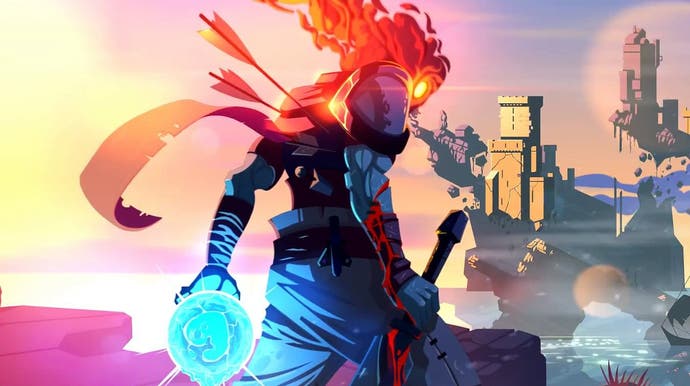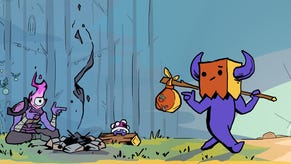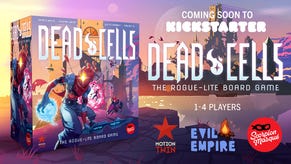Dead Cells review - one of the slickest dungeon-crawlers you'll ever play
Isle be back.
After 30-odd years of pillaging fantasy realms I'm pretty sick of video game loot, but I do love poring over the vicious trinkets I've harvested from the tissues of Dead Cells, Motion Twin's superb, handsome blend of Spelunky and Metroidvania. There they dangle in the jail where you begin each run: a galaxy of smoky coloured icons, sealed in jars that are chained to the ceiling. Bounce into them - one of my personal rituals, before I venture into the dungeon beyond - and the jars chime together ever so gently in a way that makes my skin crawl. I'm not sure the resemblance to a mad scientist's anatomy collection is deliberate, but it's compelling all the same. How better to capture the morbidity of escaping to a world of make-believe only to shake it down for swords and tat? You can almost smell the formalin.
As the name suggests, Dead Cells is rather on the macabre side. An action-platformer with permadeath, randomised rewards and procedurally generated stages, it takes place on an island overrun by undead creatures and casts you as the worst critter of the lot - a parasitic snotball that survives by reanimating the bodies of beheaded criminals. Die in your efforts to escape, and the parasite squidges back through the island's plumbing to the prison, where another corpse is always, somehow, waiting. Fortunately, once plugged into a torso the character is a formidable martial artist and a delight to control - able to perform brisk three-hit combos, double-jump, block or parry, slither around ledges, kick down doors to stun nearby foes and slam earthwards mid-jump to pulverise anything beneath.

The game's swish animations and skin-bursting effects are its immediate draw - Klei's Mark of the Ninja with a big dollop of Diablo 3 and Mortal Kombat. Besides looking tremendous, it succeeds in being thoroughly readable for all the quantity of bodies, gibs and damage numerals on show, helped no end by sound design that excels at conveying nuances like the difference between a normal and a critical hit. Also captivating: the level art, which combines the sunset palette of a Mike Mignola comic with the filigreed touches of vintage Castlevania. One stage is a hellish clocktower, cogs spinning inside walls and fragments of masonry drifting against a burning cloudscape. Another is a mildewed Siren-esque village on stilts above a river of gore, lanterns gleaming from windows in the backdrop.
If Dead Cells is glorious to behold and irresistible in the hands, what makes it stick in the long run is, firstly, the complex yet intuitive risk-reward dynamics created by its temporary boosts and permanent progression systems, and secondly, the terrific balance its stages strike between familiarity and intrigue. Let's talk about the progression aspect first. Your character has space for two melee weapons, ranged weapons, spells or shields, plus two kinds of grenade or deployable trap, most of which are colour-coded purple, green or red. You'll discover or buy new toys at random during each run - some hidden in treasure chests, some obtained from merchants, others cheekily presented to you as paired either/or drops - but you'll need to unlock the more potent varieties first by spending "cells" gleaned from the dead in the safe areas between stages. Cop it before you reach the next safe area and you'll lose any unspent cells forever, with not even the prospect of a Souls-style reclaim-your-XP mechanic as solace.
New loot options for the random number generator are the game's backbone as a traditional RPG - the nearest thing it offers to a persistent XP ladder. There are also a variety of temporary boosts. You can unlock mutations in safe areas that confer buffs such as a damage increase following a kill; you're only allowed three mutations per run, however, so it's important to pick the ones that complement your gear or tactics. Stages, meanwhile, house power-up scrolls that raise your health and enhance the performance of items of a certain colour. The colour-coding system is one of the game's masterstrokes in terms of weighty choices, because while it's obviously sensible to focus on the colours you have equipped, the health gains decrease for each point you spend on a colour. Ignore the others, and you might walk into a boss battle with 800 fewer HP, and there's always the possibility, of course, that you'll discover a tasty weapon of a different colour down the road.

This blend of run-specific incentives and trade-offs helps each of your attempts stand apart - and I've yet to discuss the weapons and gear pieces themselves. There's staggering diversity, even within categories, and each tool has its quirks. Spears that deal extra damage if you catch the target against a wall, and Spartan boots for Gerard-Butler-esque pitfall executions. Grenades that immobilise targets with coils of lightning, and grenades that release a horde of flesh-eating worms. Daggers that inflict double-damage from behind, and whips that snake past shields and drag victims into close quarters. Weapons have levels that determine their base capabilities, plus a carnival of borderline-contradictory modifiers. You might find an ice grenade that sets its victims on fire, or a sword that fires darts, or a hammer that leeches back a little health with every blow.
Combinations of weapons breed additional possibilities, and while you're often at the mercy of the randomness on this count, matching those combinations to the threats at hand is very satisfying. This blade inflicts critical damage on the third hit, but quicker foes might not give you the luxury - unless, of course, you pair it with a bow that freezes the target. This shield not only inflicts bleeding on the assailant but slops the effect across enemies nearby when you parry - allowing you to live without your hitherto-indispensable throwing knives, and pick up that ludicrous broadsword you spotted a few rooms back.
There's a strong element of balancing short against long-term advantages. An ice blast spell with a modifier that causes angry maggots to erupt from the slain might be devastating against packs, but you obviously won't reap the benefits when you're fighting a lone boss. A hammer that shuts down all comers in one stage might be too ponderous for comfort in the next stage along. Levelling items up in saferooms also shuffles their modifiers, and while it's important to keep up with expanding enemy health pools, sometimes you might want to hold off. Is the sacrifice of a mod that freezes anybody who hits you worth the additional damage?
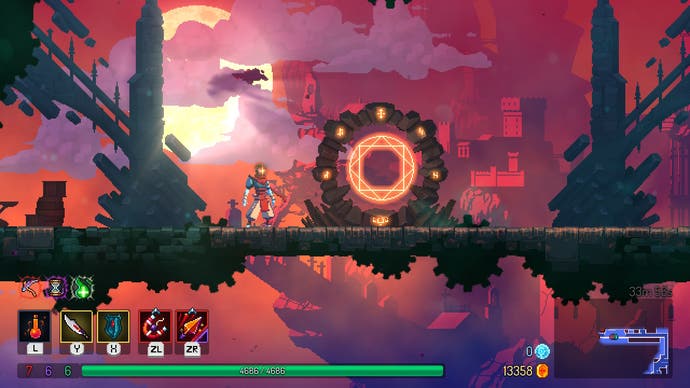
Your ability to make those calls improves, naturally, the more at home you feel with the game's stages - their changing layouts pegged down by recurring milestones such as forking paths or minibosses, plus surprises and secrets that only blossom after multiple visits. The campaign is divided into branches, with many levels housing an alternative exit that takes you to another branch; there's some mild ability gating, with certain routes only accessible once you've found specific (permanent) runes.
Each stage is beautifully distinguished, with its own unique foes, terrain setups and puzzle elements, anticipation of which soon becomes second nature as you ponder tweaks to your loadout. The Toxic Sewers, for example, are full of acid troughs that punish excessive dodge-rolling; a shock to the system next to above-ground areas where evasion is much easier. When navigating the Stilt Village you'll always face two locked doors, the keys to which are tucked away in side chambers along with a cursed treasure chest and any number of mouthy, cannon-wielding pirates. The subsequent Forgotten Sepulcher is flooded with darkness that corrodes your health, forcing you to fight in the glare of protective magic lanterns; it always concludes with a sadistic unlit stretch where you must double back through a nest of horrors after obtaining a key.
Within these broader rhythms, the game is wonderful for how it varies the challenge by throwing different enemy mix-ups into certain kinds of space. A tubby gilded gladiator with a chain harpoon might be easily confounded at close quarters, but is a very different kettle of tetanus when you're trading looks across a spikefield. A wizard whose energy bolts pass through surfaces is just a speed bump when found unescorted, but a menace when you're fighting bat demons a couple of floors down. It says a lot about the quality of a game's enemy design when the first thing you fight remains an occasional headache hours later, and I still sometimes succumb to Dead Cells' basic zombies, particularly when their wind-up animations are obscured by the antics of beefier prey.
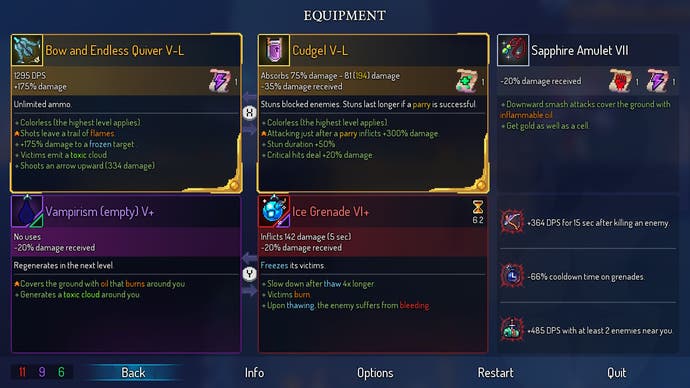
The one thing I would hold against Dead Cells is that it's an exercise in preaching to the choir. For all the deftness with which it sutures together the bleeding pieces of various genres, it's a tough game to recommend to anybody who throws up at the whiff of permadeath, or who can't see the difference between a random loot drop and a slot machine. Getting kicked back to square one can be as frustrating here as in Souls or Spelunky, though the shortness (up to an hour or two) of the average run deadens the pain - and it's always a pleasure to return to that grisly, slowly blossoming canopy of specimen jars. Such mild caveats aside, few role-playing games offer such a breadth of options within recurring structures, and few games in general manage to put across such elaborate systems with such swagger. Dead Cells might cast you as a possessed hunk of corpseflesh, but it's incredibly lively.
